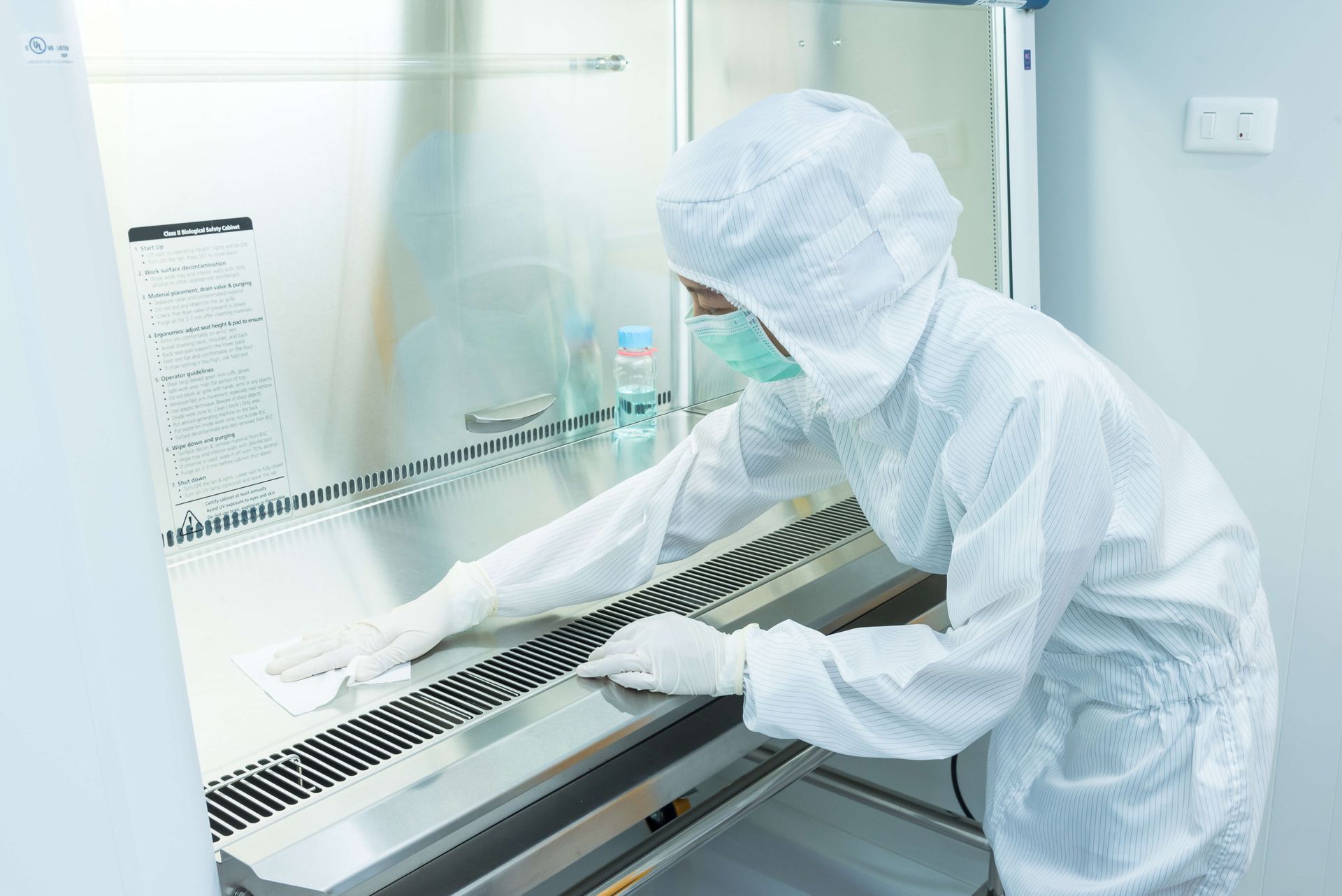By Kjeld Lund May 30, 2025
•
May 30, 2025
Introduction Electrostatic discharge (ESD) is a phenomenon that occurs when there is a sudden flow of electricity between two electrically charged objects. This discharge can be incredibly damaging, especially in environments that handle sensitive electronic components or biological materials. Cleanrooms, which are meticulously controlled environments used for various applications like semiconductor manufacturing, pharmaceuticals, biotechnology, and medical device production, must be designed to control all potential sources of contamination. ESD is one of the most critical factors in maintaining the integrity of cleanroom processes and the safety of the equipment and materials being handled. In this article, we will delve into the concept of electrostatic discharge, its impact on cleanroom environments, the best practices for controlling ESD, and the technologies used to prevent its occurrence in sensitive areas. Understanding the complexities of ESD and its control is essential for ensuring the quality, safety, and efficiency of cleanroom operations, particularly in industries dealing with advanced electronics, sensitive biological research, or high-precision manufacturing. What is Electrostatic Discharge (ESD)? Electrostatic discharge refers to the sudden transfer of electrostatic charge between two objects of different electrical potentials. This can happen when one object, often a human body, carries an electrostatic charge and comes into contact with another object, like a piece of sensitive electronic equipment or a semiconductor wafer. The charge transfer that occurs during ESD can result in short circuits, malfunctioning devices, or permanent damage to components that cannot be repaired. In cleanrooms, where precision is critical, and equipment must perform at optimal levels, even the smallest ESD event can have disastrous consequences. For example, in semiconductor manufacturing, a single static discharge could render an entire wafer batch unusable, leading to financial losses and delays in production schedules. In the pharmaceutical or medical device industry, the presence of static electricity could cause contamination or negatively affect the quality of drugs, devices, or biological samples. The Impact of ESD on Cleanrooms The impact of ESD in cleanrooms can be far-reaching, affecting both the safety of workers and the quality of the products or research being conducted. Some of the main risks of ESD in cleanroom environments include: Damage to Electronic Components : In cleanrooms, especially in industries like semiconductor manufacturing, electronics, and aerospace, ESD is one of the leading causes of damage to sensitive components. Modern electronic devices are increasingly smaller and more complex, with increasingly delicate circuits. Static electricity can destroy or degrade the functionality of integrated circuits, transistors, microchips, and other critical components, leading to failed products and costly losses. Contamination Risk : In certain cleanroom environments, such as those used in the pharmaceutical or biotechnology sectors, ESD can create sparks that ignite combustible or flammable substances. This poses a serious safety risk, especially in areas where hazardous chemicals or volatile compounds are used or stored. Additionally, uncontrolled ESD can lead to the movement of particles, which can interfere with sterile processes or experiments, further compromising the cleanliness of the environment. Loss of Product Yield : In semiconductor manufacturing, even a single ESD event can result in the loss of entire product batches. Given the high value of materials and components, the financial implications of an ESD-induced failure can be significant. For example, a microchip that is subjected to an ESD event might be rendered useless, forcing manufacturers to discard it and start the production process over. Inconsistent Test Results : In laboratories that rely on controlled environments, such as research labs in biotechnology or pharmaceuticals, ESD can introduce unpredictable variables into experiments. For example, in cell culture research, sensitive biological samples can be affected by minor static charges that disrupt the growth of cells or alter experimental results. This can lead to unreliable data, delays in research, and, in some cases, the need to repeat entire experimental procedures. Best Practices for Controlling ESD in Cleanrooms Controlling electrostatic discharge in cleanrooms is a comprehensive effort that requires the integration of various technologies, design elements, and operational practices. Cleanroom environments should be designed to minimize the accumulation and discharge of static electricity, and personnel should be trained to follow proper procedures to prevent static buildup. Here are several best practices to control ESD effectively: 1. Control of Ambient Humidity One of the most effective ways to reduce the buildup of static electricity in cleanrooms is through the careful management of humidity levels. Electrostatic charges are more likely to accumulate in environments with low humidity, as the lack of moisture in the air allows the static charge to build up and discharge more readily. By increasing humidity levels to a range of 40-60%, static buildup can be minimized. Many cleanrooms, particularly in industries like electronics and pharmaceuticals, use humidifiers as part of their HVAC systems to maintain the desired humidity levels. Proper control of temperature and humidity not only reduces static electricity but also improves overall air quality, which is important for maintaining a clean environment. 2. Anti-Static Flooring Flooring is a critical element in controlling ESD in cleanrooms. The materials used in cleanroom floors must be selected based on their ability to dissipate static charges and prevent static buildup. Anti-static and conductive flooring options, such as vinyl and rubber with conductive additives, are commonly used to control ESD in cleanrooms. Conductive Floors : Conductive flooring allows static electricity to travel safely to the ground, preventing static charges from accumulating on surfaces or equipment. Static-Dissipative Floors : These floors offer a slightly slower dissipation of charge, providing a safe environment for sensitive electronic components while minimizing the risk of electrical discharge. It is essential to ground the flooring system correctly to ensure that any accumulated static charges are safely directed away from critical equipment and personnel. 3. ESD-Safe Workstations and Furniture Workstations and furniture in cleanrooms must also be designed to minimize static buildup. Anti-static or ESD-safe work surfaces and chairs are commonly used to prevent electrostatic charge accumulation during work. These workstations are often equipped with grounding straps, which provide a pathway for any built-up static electricity to be safely discharged to the ground. Other ESD-safe equipment, such as ionizers, are also used to neutralize static charges in the work area. Ionizers generate ions that balance out the charge differential between objects, ensuring that static buildup does not reach dangerous levels. 4. Personal Protective Equipment (PPE) Personnel working in cleanrooms must wear appropriate personal protective equipment to prevent the introduction of static charges into the environment. This includes: ESD Wrist Straps : These wrist straps are designed to discharge any static electricity that may accumulate on a person’s body. They should be worn at all times when working with sensitive electronic components or equipment. ESD Gloves : Non-static generating gloves are essential to prevent the transfer of static electricity from human hands to products or work surfaces. Conductive Footwear : Anti-static or conductive footwear is crucial in maintaining a constant grounding path for personnel, preventing the buildup of static charges as they move around the cleanroom. Proper training and awareness of static control practices are critical for personnel to minimize the risks associated with ESD. Workers should be educated on the importance of ESD control, how to handle sensitive equipment, and how to use anti-static clothing and accessories effectively. 5. Ionization Systems Ionization systems are often installed in cleanrooms to neutralize static charges in the air. These systems generate ions, which help neutralize charged surfaces by balancing the electrical charge, thereby preventing static buildup. Ionizers are particularly useful in areas where humidity levels cannot be easily controlled or in processes that require extremely low levels of contamination. Ionization is especially critical in environments where sensitive electronic components are handled, such as semiconductor fabrication or assembly lines for consumer electronics. In these environments, the presence of any static charge can lead to costly damage to microchips, circuit boards, or other components. 6. ESD-Safe Packaging For cleanrooms involved in electronics assembly or semiconductor manufacturing, packaging materials must also be ESD-safe to protect sensitive components during transport and storage. Conductive or static-dissipative materials, such as antistatic bags, trays, and boxes, are used to ensure that components are not exposed to static charges. Monitoring and Maintenance To ensure that ESD control measures remain effective, cleanroom environments must be regularly monitored and maintained. This includes: Routine Grounding Inspections : Periodic checks of the grounding system (including floors, workstations, and personnel equipment) are essential to ensure that all components are properly grounded. Air Quality and Humidity Monitoring : Environmental monitoring systems should be installed to track humidity levels, temperature, and static charge buildup in real-time. This ensures that conditions remain optimal for controlling ESD and minimizing risks to sensitive equipment. Training and Protocols : Cleanroom personnel should undergo regular training on ESD control protocols, including handling ESD-sensitive equipment, using proper PPE, and understanding the risks associated with electrostatic discharge. Conclusion Controlling electrostatic discharge in cleanrooms is a critical component of maintaining the integrity of sensitive materials, equipment, and processes. ESD can cause irreparable damage to electronic components, lead to contamination in sterile environments, and even cause safety hazards. Through proper design, careful material selection, and the implementation of best practices, cleanrooms can effectively control ESD and minimize its impact on operations. By controlling ambient humidity, installing anti-static flooring, utilizing ESD-safe workstations, equipping personnel with proper protective gear, and using ionization systems, cleanroom operators can create an environment that minimizes the risks associated with electrostatic discharge. With continued monitoring and maintenance, cleanrooms can ensure that the integrity of research, manufacturing, and production processes remains intact, supporting industries where precision and safety are paramount.





